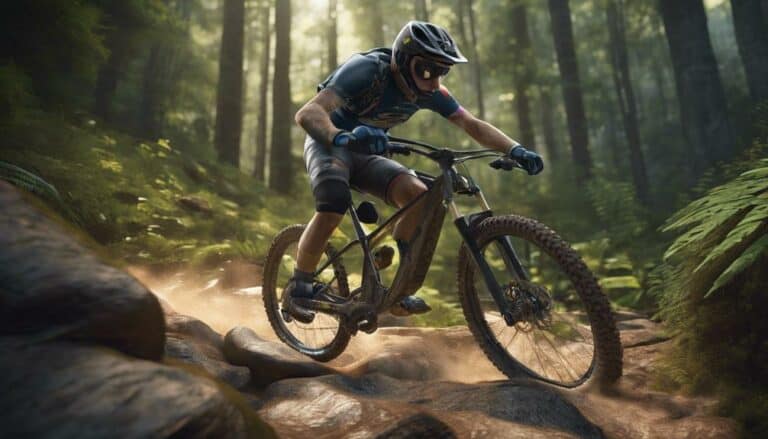If you want to truly master off-road riding, you must understand the importance of adapting your techniques to various types of trails. By honing your skills in body positioning, cornering, braking, and terrain navigation, you can tackle any terrain with confidence.
But what sets apart a good rider from a great one? It's the ability to anticipate and react to the unexpected challenges that each trail presents.
Stick around to discover the secrets to enhancing your off-road riding abilities and conquering any trail that comes your way.
Key Takeaways
- Master proper body positioning and weight distribution for control on diverse terrains.
- Adapt braking techniques to different surfaces for safe and efficient riding.
- Enhance agility by adjusting weight distribution and technique based on trail conditions.
- Develop advanced skills like fluid motion, precise braking, and effective cornering for optimal performance.
Sitting Position for Control
When riding off-road, mastering the proper sitting position is essential for maintaining control and stability on varying terrains. Your center of gravity plays a vital role in how you handle your bike. By keeping your weight centered and distributed evenly over the footpegs, you can guarantee better control and balance.
Remember to have more weight on the front of the bike to improve traction and steering, especially when moving through challenging trails.
As you ride, be mindful of moving your weight as needed, whether it's to tackle obstacles or make sharp turns. Utilize the front brake for initial slowing down and the rear brake for more controlled stops.
Body Positioning Techniques
To enhance your off-road riding skills, mastering proper body positioning techniques is key for maintaining control and agility on diverse terrains. Keeping your weight back when faced with challenging obstacles can help prevent potential risks associated with losing control of the front end.
By moving your body fluidly, you can adjust to the demands of the trail, ensuring you have best balance and stability. Remember to avoid target fixation, as this can lead to focusing on obstacles rather than the path ahead, causing you to lose control.
Keeping your weight centralized and distributing it effectively between the front end and back end of the bike is essential for moving through various terrains with confidence. Embrace the freedom of off-road riding by perfecting your body positioning techniques, allowing you to ride with skill and liberation through any adventure that comes your way.
Handling Different Trail Surfaces
Adapt your riding technique to conquer various trail surfaces with confidence and control. When faced with different terrains, mastering the art of handling diverse trail surfaces can elevate your off-road riding experience. To navigate with finesse, consider the following:
- Adjust body weight: Shift your weight to maintain traction on loose gravel, ensuring stability as you ride.
- Absorb bumps: Use your body positioning to absorb shocks on rocky terrains, enhancing balance and control.
- Smooth throttle control: On slippery mud trails, apply gentle throttle control to prevent wheel spin and maintain traction.
- Flexible stance: Keep a flexible stance on sandy surfaces, allowing your bike to glide smoothly over the terrain for improved control.
Braking Techniques for Off-Road
Mastering braking techniques is key to ensuring control and safety when managing off-road trails, especially after learning how to handle different trail surfaces. Adjust your braking pressure according to the terrain to prevent skidding and maintain control over your bike. Remember to use both your front and rear brakes to distribute braking power effectively, especially when encountering obstacles on the trail. To prevent stalling and keep your momentum, practice feathering the clutch while braking, allowing for a smoother and more controlled ride.
Emergency braking is an essential skill to have in your off-road riding arsenal. Be prepared to react quickly to unexpected obstacles by practicing emergency braking techniques regularly. Gradually increase your braking skills on various surfaces like gravel, mud, and sand to gain versatile control over your bike in different riding conditions. By honing your braking abilities, you'll be better equipped to navigate through challenging off-road environments with confidence and precision.
Advanced Trail Riding Strategies
Embrace the art of fluid motion as you navigate through challenging off-road trails with advanced trail riding strategies.
- Master body positioning techniques: Shift your weight to maintain balance and control on various terrain types.
- Hone weight transfer skills: Practice advanced techniques to handle obstacles and challenges more effectively.
- Focus on braking techniques: Mastering braking is essential for improved control and safety on different trail surfaces.
- Develop cornering strategies: Adapt your approach to cornering based on the specific conditions of each trail for best performance.
Conclusion
Congratulations on taking the first step towards mastering off-road riding techniques!
Did you know that 85% of experienced riders credit proper body positioning as the key to conquering different types of trails?
Keep practicing, honing your skills, and never stop exploring new trails.
Remember, the thrill of off-road riding lies in the continuous improvement and the sense of adventure that comes with it.
Keep pushing your limits and enjoy the ride!

